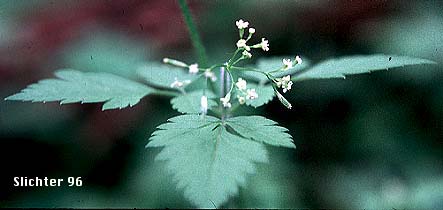Also known as Chilean sweet-cicely, common sweet cicely is a perennial wildflower with one or two slender, erect stems which are commonly branched above from 30-80 cm high. The stems and leaves are typically glabrous, or may also consist of numerous minute, stiff hairs. The basal leaves are twice ternate, the leaflets broadly ovate and deeply toothed, incised or parted. The base of the leaflets are triangular to heart-shaped. The blades of the leaflets range from 2-7 cm long and 1.5-5 cm wide and are more or less pubescent along the veins and petioles. The stem leaves are few and reduced in size.
The inflorescence consists of one to several umbels, each having 3-8 ascending to ascending-spreading rays from 3-9 cm long. The pedicels below each flower are 8-25 mm long. Bracts are typically missing from both the base of the umbel and umbellets. The petals are white or greenish-white. The fruits are covered with bristly hairs at the base and onto the body of the fruit. The tip of the fruit is noticeably narrowed to a narrow beak 1-2 mm long while the base is tapered gradually to the pedicel. The fruits are 12-22 mm long.
Common sweet cicely may be found in woodlands and along streams from the lowlands and foothills up to elevations of 3000m in the mountains at the southern extent of its range.
Common sweet cicely may be found from southern Alaska south to California on both sides of the Cascade and Sierra Nevada mountains and east to the Rocky Mts from Colorado south to Arizona and New Mexico. It may found eastward in South Dakota and also from Wisconsin and Michigan east to Ontario Newfoundland and northern New Hampshire. It is also native to Chile and Argentina.
In the Columbia River Gorge, it may be found between the elevations of 100'-4200' from the Sandy River east to around Seven Mile Hill to the west of The Dalles.
